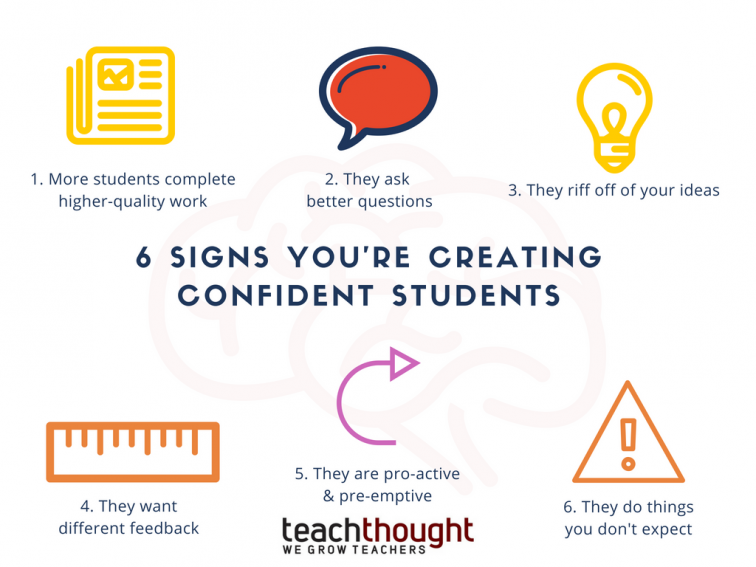
Are You Creating Confident Students?
by Terry Heick
One approach to great teaching is facilitation: decentering yourself. Standing to the side, out of the students’ way, and moving to more of a facilitative role of teaching. And one critical ingredient in such an approach is student confidence (for problem-solving, for example) and self-efficacy.
The primary difference between confidence and efficacy has to do with application. Confidence (which is more of a general and persisting belief about the self, applying to a variety of domains (school, athletics, relationships, etc.) This can also be parsed within an academic context as well: the belief that one is able to pass tests, participate in discussions, complete and hand in work on time, and so on.
Self-efficacy is similar, and can be thought of as confidence in a particular area. For example, a student may be confident about school because of a sense of self-efficacy about completing academic work, or forging relationships with peers and teachers. These “minor” episodes of self-efficacy can lead to increased confidence.
In the classroom, teachers obviously look for both: self-efficacy (I am capable of completing this task or project) and confidence (I believe in myself to finish tasks or projects in general), and realize the taut relationship between the two. Simply put, students that lack confidence or a strong sense of self-efficacy are far less likely to self-direct themselves in their own learning, or to fulfill a teacher’s requests (read this article, write this essay, solve this problem).
6 Signs You’re Creating Confident Students
A student’s own belief about their chances for successful attainment of a goal factor massively in their success.
Self-confident and efficacious students are able to persevere in the face of obstacles and challenges. In a classroom of 30+ students, the kind of interaction between student and teacher that reveals the dynamic and fluctuating levels of confidence and efficacy is difficult. But there are some signs you can look for that can highlight their growing or decaying belief levels about their own ability.
See also 10 Signs Of Plagiarism Every Teacher Should Know
1. More students complete higher-quality work.
This one is the easiest to see. Students that lack confidence and self-efficacy don’t complete work, much less do so with “quality” (a troublesome word here that we’ll just leave alone for now). While a bit obvious, more students doing better work is a sure sign of confidence.
Or blind luck.
2. They ask better questions.
Students that lack confidence may ask about due dates, assignment details, or scoring criteria, while confident students, generally speaking will ask about possible extensions of the assignment, inquire about the teacher’s personal preference for resources, immediately start pitching thesis ideas, or ask questions that get at the “big picture” of the assignment.
3. They riff off of your ideas.
Confident students take your theories, stories, resources, and other academic fodder and run with it–perhaps even changing the assignment in the process. While this seems like a simple thing, shifting from “What does the teacher want me to do here?” to “What’s most interesting about this content and how should I respond?” is a critical change.
4. They want different feedback.
As students grow in confidence, they’ll want different feedback–something other than letter grades and quick notes-in-the-margins.
In short, they’ll want learning feedback that’s meaningful and personal to them. All students need this type of feedback, but confident and self-efficacious students are more likely to recognize their own needs, advocate for themselves, and establish a rapport with teachers that helps them improve.
5. They are pro-active and pre-emptive.
As described above, confidence encourages recognition, action, and general advocacy. While this could also be proof of an organized student, a competitive student, or a student being pushed to achieve by some extrinsic force, confidence can allow learners to look ahead, anticipate barriers, and be pre-emptive in their navigation.
6. They do things you don’t expect.
Good things–grow in ways you didn’t anticipate. Faster–or in different directions than you thought they might. Do different things with what they learn than you’d have thought of, because their journey is different and you’ve helped them travel their journey and not your own.
Conclusion
While the above aren’t necessarily proof of confidence and self-efficacy, little is. Even the most seemingly confident learner could be feigning these traits to mask insecurity and uncertainty. Ultimately the goal of such confidence is a comfortable learner that deeply understands content, rather than confidence for the sake of confidence.
The role of confidence and self-efficacy in learning is broad, but not fully understood. Neither can substitute for content mastery, but they almost always precede it.
Image attribution flickr user tanozzo and deapeajay; Are You Creating Confident Students?
